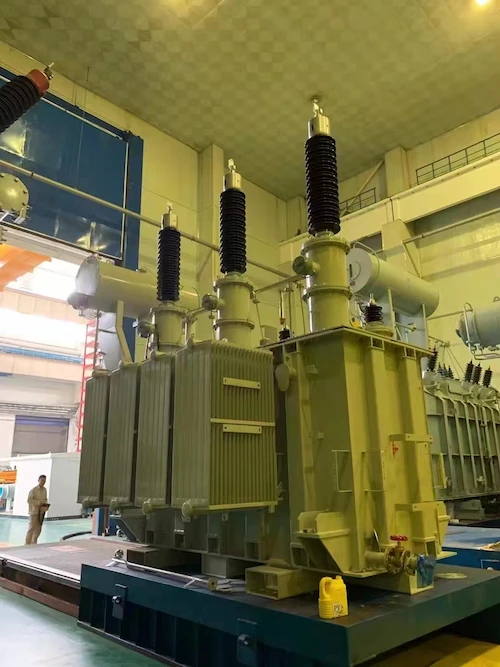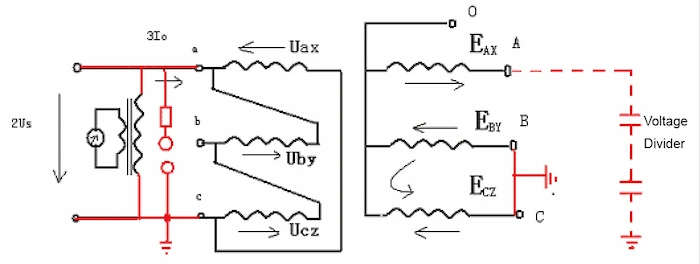ELECTRIC, WITH AN EDGE
This article focuses on the main power transformer, including how to select it? How to accept and transport? How to maintain? The text takes 110kv transformer and 220kv transformer as examples.
Hope that reading this article can help you improve the safe operation of the main transformer.
DAELIM’s power distribution systems are intended to be strong and durable, small and portable for simple handling. It is entirely adaptable to construct alternative configurations to meet your unique hazardous area requirements.
Our expert electricians are ready to provide you an expert solution to your electrical transformer needs.
How Do Choose a Power Transformer for Chemical Industry?
-For the supply and output load situation of the substation in the chemical industry, the selection of the number and capacity of transformers.
10+FAQ ABOUT THE MAIN POWER TRANSFORMER
-Daelim provides an in-depth analysis of the main power transformer. It is the type of step-up transformer! Keep on reading!
8+FAQ ABOUT THE CUSTOM POWER TRANSFORMERS
-Discover how transformers work, how to choose the right one for your project, and why custom power transformers are ideal. Read on!
In principle, use autotransformers as little as possible; except for factory-used transformers for large units of 300MW and above, split transformers should not be used; for three-winding transformers, unless necessary, the medium-voltage windings are generally not equipped with voltage-regulating windings.
110kV transformers should be selected from manufacturers that have passed the sudden short-circuit test; 220kV transformers should be provided with a calculation book for the ability to withstand short-circuits, and manufacturers that have passed the sudden short-circuit test should be selected first.
In principle, mature products with 2 years and above operating experience should be selected.
A reasonable production cycle should be reserved for the manufacturer when signing the contract.
For 110kV/31500kVA and above double-coil step-down transformers, the short-circuit impedance should be increased to 14-15%; other transformers should be selected according to the high limit of the GB6451 specified range.
The current density of the copper wire of the winding is generally not more than 2.8A/mm2.
The low-voltage windings of the following capacity transformers should use self-adhesive transposition wires:
step-up transformer 220kV/150MVA and above, 110KV/63MVA and above;
step-down transformer 500KV/750MVA three-phase integrated, 220kV/120MVA and above, 110kV/50MVA and above.
The low-voltage winding is a half-capacity three-winding transformer.
The main transformer of 110kV and above requires the use of naphthenic transformer oil.
The metal corrugated oil pillow can be popularized.
Type V can be used for on-load tap changer of transformers of 110kV/31.5MVA and below;
M type can be used for 110kV/31.5MVA and above; Daelim products can be used for 110kV important substations and 220kV transformers.
The oil-sealed dryer should be a product with good performance.
The stainless steel or copper butterfly valve with good performance should be selected.
For transformers of 220kV and above, the factory-measured value of zero sequence impedance shall be provided.

Manufacturing supervisors should select and dispatch professionals with a strong sense of responsibility and experience to participate.
Before going to manufacturing supervision, an outline for manufacturing supervision and acceptance should be prepared; at the end, a manufacturing supervision report should be submitted.
The winding assembly process.
The whole process of the factory test focuses on the withstand voltage value, the induction withstand voltage connection method (and partial discharge (including the initial discharge voltage and the extinguishing voltage).

The test report (spectrogram) of the winding deformation measured by the frequency response method and the actual measured value of the DC resistance of the winding semi-finished product should be submitted when leaving the factory.
For transformers transported with nitrogen (or air), the internal pressure should be maintained at 0.02-0.03MPa. The humidity of the filled gas should be less than 30µL/L. After the equipment is in place, the humidity of the gas in the box should be measured, and the moisture content of the internal insulating material should be calculated, and its value should be less than 1%.
Bell-shaped transformers should generally be hoisted for inspection; for transformers with welded fuel tanks, hoisted cores, and short-distance transportation, all openings should be opened, the seat raised, and people should be inspected.
When pumping a vacuum, the wheat vacuum gauge should be installed on the side of the fuel tank to prevent mercury backflow caused by misoperation.
For 110kV transformers that have been unqualified for many times in the partial discharge test or abnormal in transportation, the partial discharge test should be carried out before being put into operation.
The pressure relief valve and Buchholz relay of the newly installed transformer of 35kV and above should be tested and qualified. The pressure relief valve of transformers of 10kV and below should be tested.
Perform a full analysis of the oil quality of the transformer during acceptance.
Strictly prevent short-circuit of the transformer outlet and reduce short-circuit faults in the vicinity.
The electrical equipment on the low-voltage side of the transformer should be selected for all working conditions (such as qualified by the test of condensation) and equipment with good performance.
Strengthen the maintenance and repair of the bushings, lead wires, busbar support insulators, outlet cable heads and cable intermediate joints on each side of the main transformer to eliminate hidden dangers and prevent the main transformer from being short-circuited in the vicinity.
Avoid short-circuiting of small animals on the low-voltage side of the transformer.
Avoid ground-loss short circuits of high-voltage lines.
Eliminate misoperations such as closing with ground wire.
Strictly prevent the 6-35kV bus resonant overvoltage in the substation. A harmonic elimination device with good performance can be installed.
For neutral point insulation systems of 35kV and below, arc suppression coils or other grounding methods should be installed when the capacitance current exceeds the specified value.
The low-voltage side of the transformer must have current protection of no more than 2s.
For substations that have been put into operation and have no bus difference on the low-voltage side, the following targeted measures are adopted:
The original low-voltage side re-voltage over-current time limit should not be greater than 2s. If it does not meet the requirements, a time-limited quick-break protection should be installed. This protection meets 1.5 times the sensitivity of the low-voltage bus in the minimum mode, and in the maximum operation mode and lower level The current quick-break protection is coordinated. The action time is 0.5s-2s to jump the low-voltage side switch of the main transformer.
It is calculated that when the sensitivity and selectivity requirements cannot be met at the same time in the large and small modes, the low-voltage bus splitting and the sacrifice of the lower-level protection selectivity can be adopted, and the tripping time of the low-voltage side of the main transformer is also satisfied not to exceed 2S.
At the beginning of each year, the transformers of each plant are responsible for providing relay protection with the transformer winding deformation test conditions and the effective value of the short-circuit current when the three-phase outlet is short-circuited in the maximum operating mode. When the short-circuit current reaches 5 times the rated current of the transformer, it should cause enough Attach importance to and take measures. At the same time, the relay protection is exclusively responsible for considering the cooperation of main transformer protection and low-voltage system protection.
The above temporary change measures are reported to the provincial company safety supervision department and the transfer center for the record.
For new substations, the design unit can also consider appropriate measures. For example, a busbar differential protection is installed on the low-voltage side of the main transformer; microcomputer protection is used to reduce the time difference of protection coordination, so that the protection action time of the low-voltage side of the main transformer is not more than 2s, or the old station scheme is still used to completely solve the problem.
For the main transformer protection with the CT on the low-voltage 10 (35) kV side of the main transformer on the inside of the switch, the 10 (35) kV side composite voltage overcurrent protection requires a period of time to trip the three-side switch of the main transformer, and control its action time. More than 2.5s. This section of protection may be mismatched with the 110kV and 220kV side composite voltage overcurrent protection of the main transformer under different operation modes, and the outgoing line protection of the main transformer low voltage 10(35)kV side.
When the main transformer switch is tripped due to a short circuit, the frequency response method or low voltage impedance method winding deformation test should be carried out as soon as possible.
When the winding is moderately deformed and the content of faulty gas in the oil increases significantly, induction withstand voltage and partial discharge tests should be arranged, and a continuous online monitoring device for gas in the transformer oil can be considered.
When the winding is moderately deformed and short-circuit occurs again, the oil should be drained into the person or the hanging cover for inspection as soon as possible.
After the transformer outlet is short-circuited three times, comprehensive diagnosis should be made based on the test results of winding deformation and oil chromatogram, and measures such as draining oil into people or hanging cover inspection should be taken.
Under normal circumstances, the first (5 years) overhaul of the hanging cover should be arranged, which can be carried out in conjunction with the state overhaul in the future. The pressure relief valve and Buchholz relay shall be tested during the overhaul.
Strengthen the anti-moisture and anti-aging work.
The oil pillow seal must be reliable and should be inspected in conjunction with the annual inspection. If the capsule or diaphragm is aging and invalid, it can be transformed into a metal corrugated oil pillow.
The oil seal dryer should be inspected and maintained every March and October to keep it in good condition. During the annual inspection, the sediment in the oil confinement tank should be discharged.
In general, water cooling is not used for transformers. For transformers that have adopted the water cooling method, the moisture content in the oil should be measured every month, and conditions should be created to carry out continuous online monitoring of the moisture in the oil.
For transformers that have been in operation for more than 10 years, the furfural content in the oil is measured every 1-2 years.
If it is a thin insulating structure, it should be retired and renewed; the gas content test in the oil should be strengthened before decommissioning.
When an abnormality is found, the hanging cover inspection should be carried out to further determine whether the operation can continue.
When overhauling the hanging cover or entering the internal inspection, use qualified transformer oil to wash the low-voltage corner wiring wooden bracket and alternate laminated cardboard.
Combined with the annual inspection, the on-load voltage regulator switch switch recording should be carried out. Strengthen the quality supervision and maintenance of autotransformer on-load tap changer oil.
For 220kV important substations whose main transformer on-load tap-regulating switch operates more than 5 times a day and the 110kV direct-loaded main transformer on-load tap-regulating switch operates more than 10 times per day, an online oil purification device can be installed.
Enough attention should be paid to transformers with intermittent C2H2, and conditions should be created for inspection.
The quality supervision of the main transformer overhaul process should be strengthened, and the overhaul quality acceptance should be organized carefully.
A complete transformer account and equipment file materials (including transformer defects and failure records, maintenance records, etc.) should be established.
Actively create conditions to carry out online monitoring and condition maintenance of transformers.
When you need to find more than just existing transformers, Daelim’s Transformer Service Center can help you design and produce distribution transformers that meet your unique needs.
We have our own factory and a professional team of engineers, which can design and modify application requirements that meet all your conditions.
Download Resource
ELECTRIC, WITH AN ENGE-- DAELIM BELEFIC
After filling in the contact information, you can download the PDF.